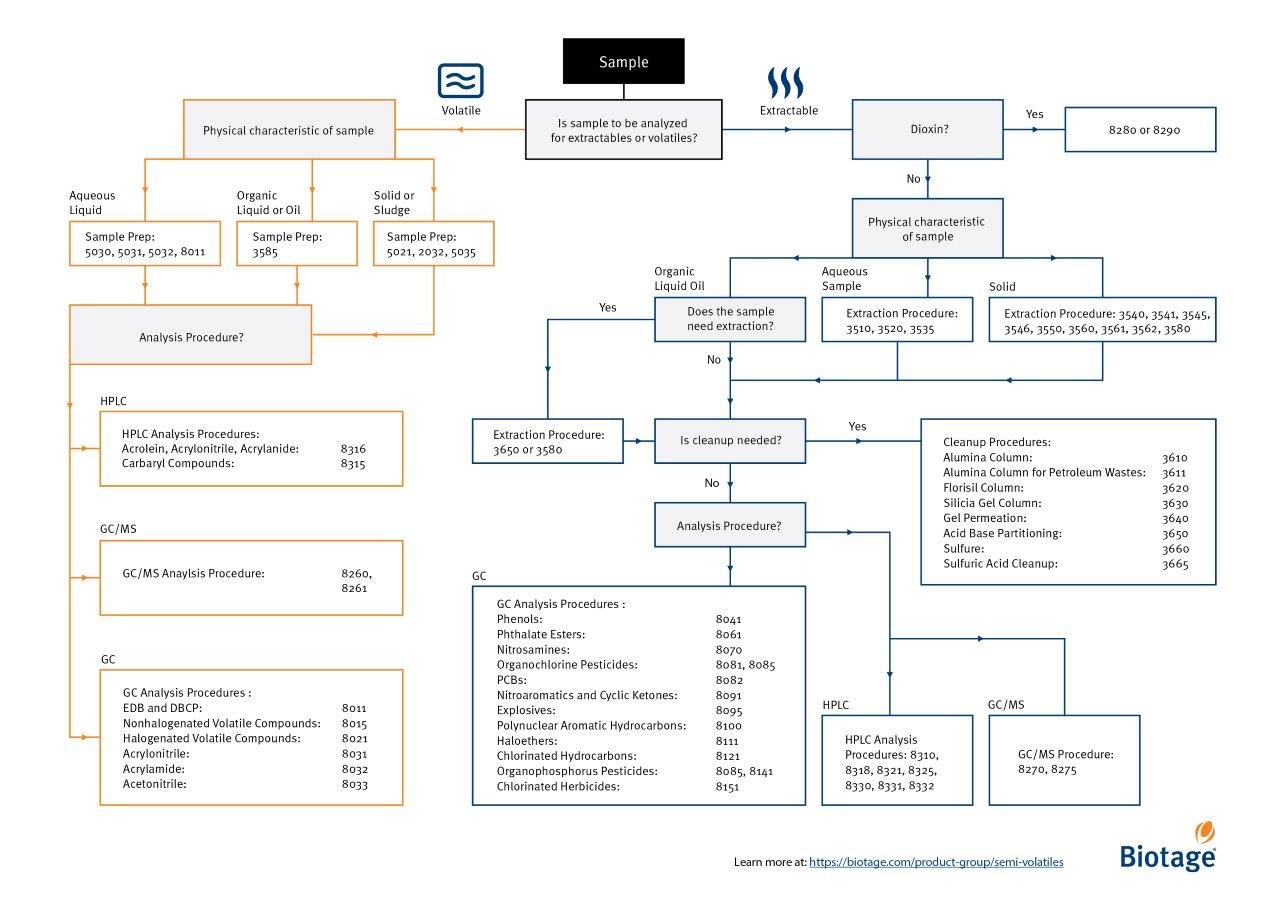EPA Method 8270 is one of the 8000 series methods that outlines the preparation of wastewater samples. It is one of dozens of methods for processing wastewaters for semivolatile organic compounds (SVOCs), all of which fall under Method SW-846. Expand the graphic below to see the breadth of the method.
 As you can imagine such a complicated method generates a lot of questions. It is a regular occurrence for me to get various questions about EPA methods but recently I have had quite a few about EPA Method 8270 and I wanted to share them in case someone else has the same questions. You can find a great summary of Method 8270 in this blog that one of my colleagues recently wrote – Extraction of Polyphenols in Tea with Lemon Juice.
As you can imagine such a complicated method generates a lot of questions. It is a regular occurrence for me to get various questions about EPA methods but recently I have had quite a few about EPA Method 8270 and I wanted to share them in case someone else has the same questions. You can find a great summary of Method 8270 in this blog that one of my colleagues recently wrote – Extraction of Polyphenols in Tea with Lemon Juice.
Q: Do I need a carbon cartridge for my 8270 extraction?
A: The answer to this question is – it depends. The purpose of the carbon cartridge is to collect the light end compounds that are not retained by the Atlantic® One Pass disk. Which compounds are on this list? There are a handful, but some of the more interesting compounds are those related to NDMA, benzyl alcohol, as well as surrogates like phenol-d5 and 2-fluorophenol. When I analyze samples using Method 8270, I look at quite a few classes of compounds and some of them require a carbon cartridge to ensure that my recoveries are acceptable.
As a side note, NDMA is a known carcinogen and has made news headlines because the recalled blood pressure medication, Valsartan, was found to be tainted with NDMA. The EPA also put out a technical fact sheet on NDMA in 2014 that provides some interesting facts.
Q: What is the purpose of the acetone in the elution steps using the Atlantic® One Pass disk and carbon cartridge using the method in your application note?
A: Well, one reason to use acetone is for elution. That’s not the main reason for using this solvent, however. Samples that are processed using Method 8270 are typically dirty samples with high levels of particulates or suspended solids. That means a decent amount of sediment will need to be filtered by your Fast Flow Disk Holder. In the process of filtering out the solid material, some of your water could get trapped in the disk holder. If we moved straight from the aqueous phase to using dichloromethane (DCM) – which is immiscible with water – the residual water would form a barrier, preventing the DCM from passing through the disk. Acetone removes any residual water before DCM is used.
Once the DCM step is complete, acetone is used again to remove any residual DCM. The next step in the elution process involves the use of 1% ammonium hydroxide (NH4OH) in water so all remaining DCM must be gone before proceeding to this step. Believe it or not, acetone is used once again after the dilute ammonium hydroxide solution has passed through the disk because DCM is used to elute analytes from the carbon cartridge. When you think about it, acetone is pretty integral to the elution process!
Fun fact: The carbon cartridge is loaded from the bottom up in the sample processing stage so you don’t have to use as much solvent to elute your target analytes.

 Organic Workflow
Organic Workflow Peptide Workflow
Peptide Workflow Scale-Up Flash Purification
Scale-Up Flash Purification  Sample Preparation
Sample Preparation Biomolecule Purification
Biomolecule Purification Oligo synthesis
Oligo synthesis Scavengers and Reagents
Scavengers and Reagents Service & Support
Service & Support Accessories & Spare parts
Accessories & Spare parts Investors
Investors Reports & News
Reports & News The Share
The Share Corporate Governance
Corporate Governance Calendar
Calendar Sustainability
Sustainability Our Offering
Our Offering Our History
Our History Our Locations
Our Locations Leadership
Leadership